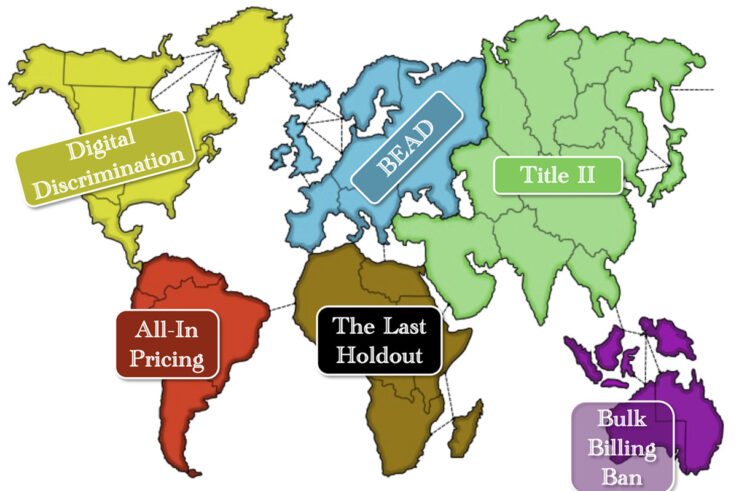
U.S. and European competition laws diverge in numerous ways that have important real-world effects. Understanding these differences is vital, particularly as lawmakers in the United States, and the rest of the world, consider adopting a more “European” approach to competition.
In broad terms, the European approach is more centralized and political. The European Commission’s Directorate General for Competition (DG Comp) has significant de facto discretion over how the law is enforced. This contrasts with the common law approach of the United States, in which courts elaborate upon open-ended statutes through an iterative process of case law. In other words, the European system was built from the top down, while U.S. antitrust relies on a bottom-up approach, derived from arguments made by litigants (including the government antitrust agencies) and defendants (usually businesses).
This procedural divergence has significant ramifications for substantive law. European competition law includes more provisions akin to de facto regulation. This is notably the case for the “abuse of dominance” standard, in which a “dominant” business can be prosecuted for “abusing” its position by charging high prices or refusing to deal with competitors. By contrast, the U.S. system places more emphasis on actual consumer outcomes, rather than the nature or “fairness” of an underlying practice.
The American system thus affords firms more leeway to exclude their rivals, so long as this entails superior benefits for consumers. This may make the U.S. system more hospitable to innovation, since there is no built-in regulation of conduct for innovators who acquire a successful market position fairly and through normal competition.
In this post, we discuss some key differences between the two systems—including in areas like predatory pricing and refusals to deal—as well as the discretionary power the European Commission enjoys under the European model.
Exploitative Abuses
U.S. antitrust is, by and large, unconcerned with companies charging what some might consider “excessive” prices. The late Associate Justice Antonin Scalia, writing for the Supreme Court majority in the 2003 case Verizon v. Trinko, observed that:
The mere possession of monopoly power, and the concomitant charging of monopoly prices, is not only not unlawful; it is an important element of the free-market system. The opportunity to charge monopoly prices—at least for a short period—is what attracts “business acumen” in the first place; it induces risk taking that produces innovation and economic growth.
This contrasts with European competition-law cases, where firms may be found to have infringed competition law because they charged excessive prices. As the European Court of Justice (ECJ) held in 1978’s United Brands case: “In this case charging a price which is excessive because it has no reasonable relation to the economic value of the product supplied would be such an abuse.”
While United Brands was the EU’s foundational case for excessive pricing, and the European Commission reiterated that these allegedly exploitative abuses were possible when it published its guidance paper on abuse of dominance cases in 2009, the commission had for some time demonstrated apparent disinterest in bringing such cases. In recent years, however, both the European Commission and some national authorities have shown renewed interest in excessive-pricing cases, most notably in the pharmaceutical sector.
European competition law also penalizes so-called “margin squeeze” abuses, in which a dominant upstream supplier charges a price to distributors that is too high for them to compete effectively with that same dominant firm downstream:
[I]t is for the referring court to examine, in essence, whether the pricing practice introduced by TeliaSonera is unfair in so far as it squeezes the margins of its competitors on the retail market for broadband connection services to end users. (Konkurrensverket v TeliaSonera Sverige, 2011)
As Scalia observed in Trinko, forcing firms to charge prices that are below a market’s natural equilibrium affects firms’ incentives to enter markets, notably with innovative products and more efficient means of production. But the problem is not just one of market entry and innovation. Also relevant is the degree to which competition authorities are competent to determine the “right” prices or margins.
As Friedrich Hayek demonstrated in his influential 1945 essay The Use of Knowledge in Society, economic agents use information gleaned from prices to guide their business decisions. It is this distributed activity of thousands or millions of economic actors that enables markets to put resources to their most valuable uses, thereby leading to more efficient societies. By comparison, the efforts of central regulators to set prices and margins is necessarily inferior; there is simply no reasonable way for competition regulators to make such judgments in a consistent and reliable manner.
Given the substantial risk that investigations into purportedly excessive prices will deter market entry, such investigations should be circumscribed. But the court’s precedents, with their myopic focus on ex post prices, do not impose such constraints on the commission. The temptation to “correct” high prices—especially in the politically contentious pharmaceutical industry—may thus induce economically unjustified and ultimately deleterious intervention.
Predatory Pricing
A second important area of divergence concerns predatory-pricing cases. U.S. antitrust law subjects allegations of predatory pricing to two strict conditions:
- Monopolists must charge prices that are below some measure of their incremental costs; and
- There must be a realistic prospect that they will able to recoup these initial losses.
In laying out its approach to predatory pricing, the U.S. Supreme Court has identified the risk of false positives and the clear cost of such errors to consumers. It thus has particularly stressed the importance of the recoupment requirement. As the court found in 1993’s Brooke Group Ltd. v. Brown & Williamson Tobacco Corp., without recoupment, “predatory pricing produces lower aggregate prices in the market, and consumer welfare is enhanced.”
Accordingly, U.S. authorities must prove that there are constraints that prevent rival firms from entering the market after the predation scheme, or that the scheme itself would effectively foreclose rivals from entering the market in the first place. Otherwise, the predator would be undercut by competitors as soon as it attempts to recoup its losses by charging supra-competitive prices.
Without the strong likelihood that a monopolist will be able to recoup lost revenue from underpricing, the overwhelming weight of economic evidence (to say nothing of simple logic) is that predatory pricing is not a rational business strategy. Thus, apparent cases of predatory pricing are most likely not, in fact, predatory; deterring or punishing them would actually harm consumers.
By contrast, the EU employs a more expansive legal standard to define predatory pricing, and almost certainly risks injuring consumers as a result. Authorities must prove only that a company has charged a price below its average variable cost, in which case its behavior is presumed to be predatory. Even when a firm charges prices that are between its average variable and average total cost, it can be found guilty of predatory pricing if authorities show that its behavior was part of a plan to eliminate a competitor. Most significantly, in neither case is it necessary for authorities to show that the scheme would allow the monopolist to recoup its losses.
[I]t does not follow from the case?law of the Court that proof of the possibility of recoupment of losses suffered by the application, by an undertaking in a dominant position, of prices lower than a certain level of costs constitutes a necessary precondition to establishing that such a pricing policy is abusive. (France Télécom v Commission, 2009).
This aspect of the legal standard has no basis in economic theory or evidence—not even in the “strategic” economic theory that arguably challenges the dominant Chicago School understanding of predatory pricing. Indeed, strategic predatory pricing still requires some form of recoupment, and the refutation of any convincing business justification offered in response. For example, ??in a 2017 piece for the Antitrust Law Journal, Steven Salop lays out the “raising rivals’ costs” analysis of predation and notes that recoupment still occurs, just at the same time as predation:
[T]he anticompetitive conditional pricing practice does not involve discrete predatory and recoupment periods, as in the case of classical predatory pricing. Instead, the recoupment occurs simultaneously with the conduct. This is because the monopolist is able to maintain its current monopoly power through the exclusionary conduct.
The case of predatory pricing illustrates a crucial distinction between European and American competition law. The recoupment requirement embodied in American antitrust law serves to differentiate aggressive pricing behavior that improves consumer welfare—because it leads to overall price decreases—from predatory pricing that reduces welfare with higher prices. It is, in other words, entirely focused on the welfare of consumers.
The European approach, by contrast, reflects structuralist considerations far removed from a concern for consumer welfare. Its underlying fear is that dominant companies could use aggressive pricing to engender more concentrated markets. It is simply presumed that these more concentrated markets are invariably detrimental to consumers. Both the Tetra Pak and France Télécom cases offer clear illustrations of the ECJ’s reasoning on this point:
[I]t would not be appropriate, in the circumstances of the present case, to require in addition proof that Tetra Pak had a realistic chance of recouping its losses. It must be possible to penalize predatory pricing whenever there is a risk that competitors will be eliminated… The aim pursued, which is to maintain undistorted competition, rules out waiting until such a strategy leads to the actual elimination of competitors. (Tetra Pak v Commission, 1996).
Similarly:
[T]he lack of any possibility of recoupment of losses is not sufficient to prevent the undertaking concerned reinforcing its dominant position, in particular, following the withdrawal from the market of one or a number of its competitors, so that the degree of competition existing on the market, already weakened precisely because of the presence of the undertaking concerned, is further reduced and customers suffer loss as a result of the limitation of the choices available to them. (France Télécom v Commission, 2009).
In short, the European approach leaves less room to analyze the concrete effects of a given pricing scheme, leaving it more prone to false positives than the U.S. standard explicated in the Brooke Group decision. Worse still, the European approach ignores not only the benefits that consumers may derive from lower prices, but also the chilling effect that broad predatory pricing standards may exert on firms that would otherwise seek to use aggressive pricing schemes to attract consumers.
Refusals to Deal
U.S. and EU antitrust law also differ greatly when it comes to refusals to deal. While the United States has limited the ability of either enforcement authorities or rivals to bring such cases, EU competition law sets a far lower threshold for liability.
As Justice Scalia wrote in Trinko:
Aspen Skiing is at or near the outer boundary of §2 liability. The Court there found significance in the defendant’s decision to cease participation in a cooperative venture. The unilateral termination of a voluntary (and thus presumably profitable) course of dealing suggested a willingness to forsake short-term profits to achieve an anticompetitive end. (Verizon v Trinko, 2003.)
This highlights two key features of American antitrust law with regard to refusals to deal. To start, U.S. antitrust law generally does not apply the “essential facilities” doctrine. Accordingly, in the absence of exceptional facts, upstream monopolists are rarely required to supply their product to downstream rivals, even if that supply is “essential” for effective competition in the downstream market. Moreover, as Justice Scalia observed in Trinko, the Aspen Skiing case appears to concern only those limited instances where a firm’s refusal to deal stems from the termination of a preexisting and profitable business relationship.
While even this is not likely the economically appropriate limitation on liability, its impetus—ensuring that liability is found only in situations where procompetitive explanations for the challenged conduct are unlikely—is completely appropriate for a regime concerned with minimizing the cost to consumers of erroneous enforcement decisions.
As in most areas of antitrust policy, EU competition law is much more interventionist. Refusals to deal are a central theme of EU enforcement efforts, and there is a relatively low threshold for liability.
In theory, for a refusal to deal to infringe EU competition law, it must meet a set of fairly stringent conditions: the input must be indispensable, the refusal must eliminate all competition in the downstream market, and there must not be objective reasons that justify the refusal. Moreover, if the refusal to deal involves intellectual property, it must also prevent the appearance of a new good.
In practice, however, all of these conditions have been relaxed significantly by EU courts and the commission’s decisional practice. This is best evidenced by the lower court’s Microsoft ruling where, as John Vickers notes:
[T]he Court found easily in favor of the Commission on the IMS Health criteria, which it interpreted surprisingly elastically, and without relying on the special factors emphasized by the Commission. For example, to meet the “new product” condition it was unnecessary to identify a particular new product… thwarted by the refusal to supply but sufficient merely to show limitation of technical development in terms of less incentive for competitors to innovate.
EU competition law thus shows far less concern for its potential chilling effect on firms’ investments than does U.S. antitrust law.
Vertical Restraints
There are vast differences between U.S. and EU competition law relating to vertical restraints—that is, contractual restraints between firms that operate at different levels of the production process.
On the one hand, since the Supreme Court’s Leegin ruling in 2006, even price-related vertical restraints (such as resale price maintenance (RPM), under which a manufacturer can stipulate the prices at which retailers must sell its products) are assessed under the rule of reason in the United States. Some commentators have gone so far as to say that, in practice, U.S. case law on RPM almost amounts to per se legality.
Conversely, EU competition law treats RPM as severely as it treats cartels. Both RPM and cartels are considered to be restrictions of competition “by object”—the EU’s equivalent of a per se prohibition. This severe treatment also applies to non-price vertical restraints that tend to partition the European internal market.
Furthermore, in the Consten and Grundig ruling, the ECJ rejected the consequentialist, and economically grounded, principle that inter-brand competition is the appropriate framework to assess vertical restraints:
Although competition between producers is generally more noticeable than that between distributors of products of the same make, it does not thereby follow that an agreement tending to restrict the latter kind of competition should escape the prohibition of Article 85(1) merely because it might increase the former. (Consten SARL & Grundig-Verkaufs-GMBH v. Commission of the European Economic Community, 1966).
This treatment of vertical restrictions flies in the face of longstanding mainstream economic analysis of the subject. As Patrick Rey and Jean Tirole conclude:
Another major contribution of the earlier literature on vertical restraints is to have shown that per se illegality of such restraints has no economic foundations.
Unlike the EU, the U.S. Supreme Court in Leegin took account of the weight of the economic literature, and changed its approach to RPM to ensure that the law no longer simply precluded its arguable consumer benefits, writing: “Though each side of the debate can find sources to support its position, it suffices to say here that economics literature is replete with procompetitive justifications for a manufacturer’s use of resale price maintenance.” Further, the court found that the prior approach to resale price maintenance restraints “hinders competition and consumer welfare because manufacturers are forced to engage in second-best alternatives and because consumers are required to shoulder the increased expense of the inferior practices.”
The EU’s continued per se treatment of RPM, by contrast, strongly reflects its “precautionary principle” approach to antitrust. European regulators and courts readily condemn conduct that could conceivably injure consumers, even where such injury is, according to the best economic understanding, exceedingly unlikely. The U.S. approach, which rests on likelihood rather than mere possibility, is far less likely to condemn beneficial conduct erroneously.
Political Discretion in European Competition Law
EU competition law lacks a coherent analytical framework like that found in U.S. law’s reliance on the consumer welfare standard. The EU process is driven by a number of laterally equivalent—and sometimes mutually exclusive—goals, including industrial policy and the perceived need to counteract foreign state ownership and subsidies. Such a wide array of conflicting aims produces lack of clarity for firms seeking to conduct business. Moreover, the discretion that attends this fluid arrangement of goals yields an even larger problem.
The Microsoft case illustrates this problem well. In Microsoft, the commission could have chosen to base its decision on various potential objectives. It notably chose to base its findings on the fact that Microsoft’s behavior reduced “consumer choice.”
The commission, in fact, discounted arguments that economic efficiency may lead to consumer welfare gains, because it determined “consumer choice” among media players was more important:
Another argument relating to reduced transaction costs consists in saying that the economies made by a tied sale of two products saves resources otherwise spent for maintaining a separate distribution system for the second product. These economies would then be passed on to customers who could save costs related to a second purchasing act, including selection and installation of the product. Irrespective of the accuracy of the assumption that distributive efficiency gains are necessarily passed on to consumers, such savings cannot possibly outweigh the distortion of competition in this case. This is because distribution costs in software licensing are insignificant; a copy of a software programme can be duplicated and distributed at no substantial effort. In contrast, the importance of consumer choice and innovation regarding applications such as media players is high. (Commission Decision No. COMP. 37792 (Microsoft)).
It may be true that tying the products in question was unnecessary. But merely dismissing this decision because distribution costs are near-zero is hardly an analytically satisfactory response. There are many more costs involved in creating and distributing complementary software than those associated with hosting and downloading. The commission also simply asserts that consumer choice among some arbitrary number of competing products is necessarily a benefit. This, too, is not necessarily true, and the decision’s implication that any marginal increase in choice is more valuable than any gains from product design or innovation is analytically incoherent.
The Court of First Instance was only too happy to give the commission a pass in its breezy analysis; it saw no objection to these findings. With little substantive reasoning to support its findings, the court fully endorsed the commission’s assessment:
As the Commission correctly observes (see paragraph 1130 above), by such an argument Microsoft is in fact claiming that the integration of Windows Media Player in Windows and the marketing of Windows in that form alone lead to the de facto standardisation of the Windows Media Player platform, which has beneficial effects on the market. Although, generally, standardisation may effectively present certain advantages, it cannot be allowed to be imposed unilaterally by an undertaking in a dominant position by means of tying.
The Court further notes that it cannot be ruled out that third parties will not want the de facto standardisation advocated by Microsoft but will prefer it if different platforms continue to compete, on the ground that that will stimulate innovation between the various platforms. (Microsoft Corp. v Commission, 2007)
Pointing to these conflicting effects of Microsoft’s bundling decision, without weighing either, is a weak basis to uphold the commission’s decision that consumer choice outweighs the benefits of standardization. Moreover, actions undertaken by other firms to enhance consumer choice at the expense of standardization are, on these terms, potentially just as problematic. The dividing line becomes solely which theory the commission prefers to pursue.
What such a practice does is vest the commission with immense discretionary power. Any given case sets up a “heads, I win; tails, you lose” situation in which defendants are easily outflanked by a commission that can change the rules of its analysis as it sees fit. Defendants can play only the cards that they are dealt. Accordingly, Microsoft could not successfully challenge a conclusion that its behavior harmed consumers’ choice by arguing that it improved consumer welfare, on net.
By selecting, in this instance, “consumer choice” as the standard to be judged, the commission was able to evade the constraints that might have been imposed by a more robust welfare standard. Thus, the commission can essentially pick and choose the objectives that best serve its interests in each case. This vastly enlarges the scope of potential antitrust liability, while also substantially decreasing the ability of firms to predict when their behavior may be viewed as problematic. It leads to what, in U.S. courts, would be regarded as an untenable risk of false positives that chill innovative behavior and create nearly unwinnable battles for targeted firms.





